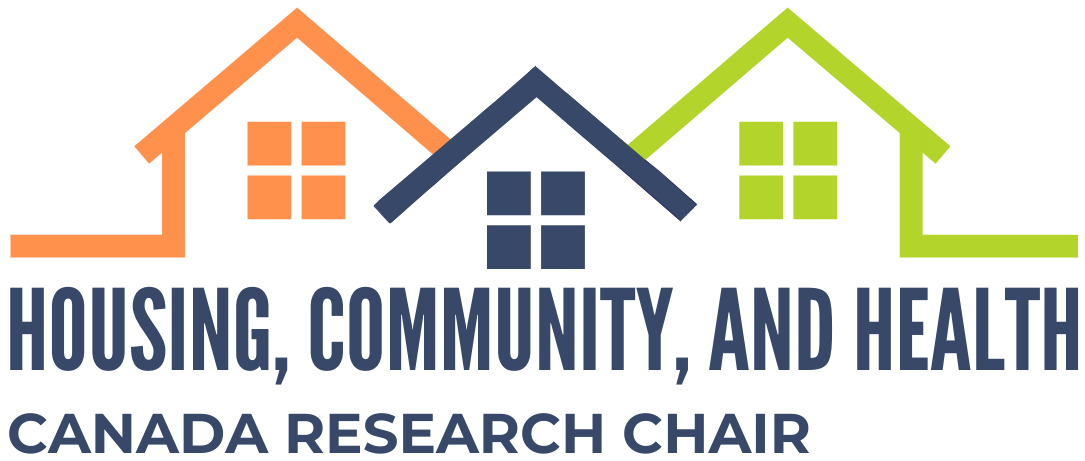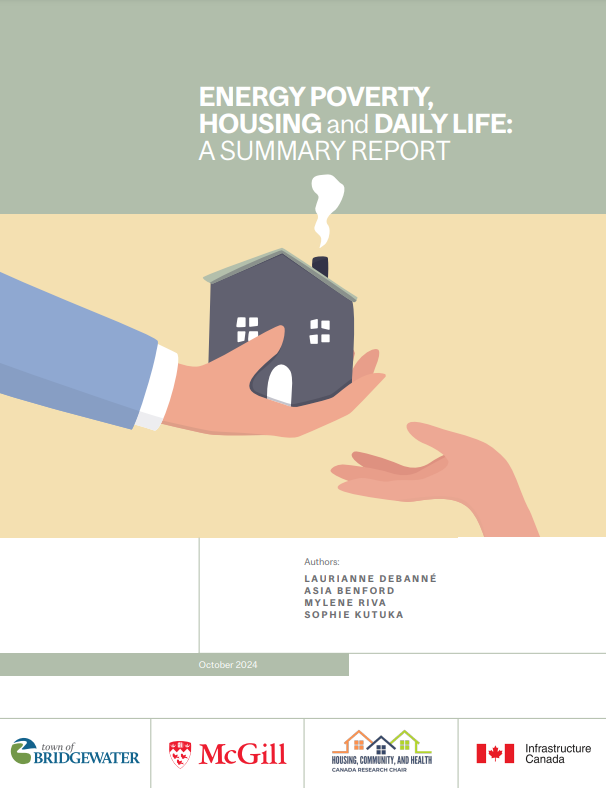Energy and Health
Research projects under this theme relate to understanding how community conditions, such as levels of deprivation and inequality, urban-rural location, and housing conditions, influence peoples’ health and well-being.
PRISE - Prévenir et Réduire la Précarité Énergétique au Quebec
(2022-2025)
Les Québécois profitent des tarifs d’électricité parmi les plus bas. Néanmoins, selon la mesure retenue, entre 9% et 16% des ménages sont en précarité énergétique, une situation qui survient lorsqu’un ménage n’a pas les moyens financiers ou l’accès à des services énergétiques résidentiels adéquats (p.ex. chauffage, climatisation, électricité, utilisation d’appareils ménagers, etc.) pour maintenir une température ambiante confortable, répondre à ses besoins et vivre dans la dignité. Il existe d’importantes inégalités dans la distribution sociale et spatiale de la précarité énergétique; y être exposé a des effets délétères sur la santé physique et mentale, le bien-être, et l’inclusion sociale.
Alors qu’elle est d’autant plus importante à considérer dans le contexte de la transition énergétique, la précarité énergétique est largement absente des politiques énergétiques et sociales, tant au Québec qu’au Canada. Dans son engagement dans la lutte aux changements climatiques, le Québec s’est doté d’un Plan directeur en transition, innovation et efficacité énergétiques. Un des grands axes d’action vise le secteur résidentiel, avec l’objectif de stimuler et d’accompagner un vaste chantier de rénovation et de construction écoénergétique des bâtiments résidentiels. À cette fin, différents programmes ont déjà été mis en place. Or, si leurs impacts sociaux et distributifs ne sont pas considérés, il est possible que ces programmes et, de façon plus large, les initiatives pour favoriser la transition énergétique, créent ou exacerbent des iniquités et contribuent à augmenter la précarité énergétique.
Afin d’améliorer les connaissances sur la précarité énergétique, d’anticiper les effets des initiatives la visant sur les inégalités sociales et de santé, et de guider une transition énergétique et climatique qui soit équitable pour tous les Québécois, cette étude poursuit quatre objectifs:
- Identifier les facteurs associés à la précarité énergétique et quantifier son effet sur la santé et le bien-être
- Comprendre l’expérience vécue de la précarité énergétique et les stratégies déployées par les ménages pour y faire face
- Analyser les initiatives qui visent la précarité énergétique sous l’angle de la justice énergétique
- Identifier des actions qui pourraient contribuer de façon significative à la prévention et à la réduction de la précarité énergétique, en portant une attention particulière à l’équité.
Différentes sources de données et méthodes d’analyse seront combinées pour réaliser ces objectifs. Les résultats de cette étude permettront d’apprécier les causes, l’étendue et l’expérience vécue de la précarité énergétique au Québec et de ses effets socio-sanitaires pour différents groupes de la population, et notamment pour les personnes et ménages en situation de pauvreté et d’exclusion sociale. Ils permettront aussi de soutenir les décideurs du Québec dans l’orientation des politiques et programmes d’actions sur les changements climatiques et la transition énergétique, avec un accent mis sur les actions destinées à améliorer l’efficacité énergétique des logements et réduire le fardeau des coûts énergétiques pour les ménages.
Équipe de recherche
L’étude PRISE est dirigée par Mylène Riva, professeure agrégée au Département de Géographie de l’Université McGill et titulaire de la Chaire de recherche du Canada sur le Logement, la communauté et la santé, avec la contribution de Prof. Sébastien Breau (Géographie, Université McGill), Prof. Caroline Adam (Techniques de Travail social, Cégep du Vieux-Montréal), et Prof. Runa R. Das (College of Interdisciplinary Studies, Royal Roads University). L’étude PRISE est réalisée en collaboration avec Isabelle Thibeault et Émilie Laurin-Dansereau des ACEFs du Sud-Ouest et de Nord de Montréal. La coordination de l’étude est assurée par Sophie Kingunza-Makasi, professionnelle de recherche au Département de Géographie de McGill.
Financement
L’étude PRISE est financée par les Fonds de Recherche du Québec – Société et Culture dans le cadre des Actions concertées - Programme de recherche sur la pauvreté et l’exclusion sociale – Phase 5, et par le I+P Partnership Program de l’Université McGill.
Bridgewater Energy Security (BridgES)
(2022-2025)
In Canada, depending on the measure, 8% to 19% of households are in energy poverty, a situation where households are unable to access or afford adequate energy services at home to meet their needs and maintain healthy indoor temperatures. In Atlantic Canada, over 30% of households are energy-poor. Energy poverty is a risk factor for cardiovascular and respiratory diseases, can exacerbate certain chronic conditions, and has been associated with poorer mental health, increased stress, and limited participation in society. Interventions to curb energy poverty, such as those targeting residential energy efficiency, have been shown to improve a range of health outcomes in varied population groups. Yet, most of the intervention research related to energy poverty has taken place abroad, and most often in European countries with mild climates. Canadian interventions have yet to be assessed for their health impacts and scalability.
In Nova Scotia, the Town of Bridgewater is tackling energy poverty head-on. The Town won the $5M prize from Infrastructure Canada’s Smart Cities Challenge to implement Energize Bridgewater, a community-wide program designed to reduce energy poverty in the community by 20% in 5 years, and by 62% in 10 years. Energize Bridgewater takes a ‘whole system’, implementing various components to tackle energy poverty across household and community scales: i) residential energy efficiency improvements; ii) coordinated access services and support programs for households living in energy poverty; iii) improvements in the offer of public transportation to offset the costs of private transportation; and iv) community outreach on energy-related issues. Energize Bridgewater has the potential to reduce energy poverty and improve health for the community as a whole and for households enrolled in specific components. The full programmatic implementation of the Energize Bridgewater started in the Fall of 2022.
Objective and research questions
The objective of BridgES (Bridgewater Energy Security) is to provide a thorough assessment of the health impacts of Energize Bridgewater, at the community and individual levels. BridgES aims to answer the following research questions:
- What is the extent of energy poverty in Bridgewater before the implementation of Energize Bridgewater? How does energy poverty relate to health in the community? Are there changes over time in community-level energy poverty and health outcomes?
- Is participation in Energize Bridgewater associated with improvements in health? If so, how, for whom, and under what conditions?
- What is the potential for the Energize Bridgewater to be implemented in other communities?
Methods
BridgES is a mixed methods study, conducted in close partnership with the Town of Bridgewater and Public Health Western Zone, Nova Scotia Health Authority. Its methodological approach combines: 1) quantitative data from a community-wide survey conducted before the full implementation of Energize Bridgewater (May 2022) and at three-year follow-up (March 2025); 2) longitudinal survey and in-depth interview data collected from households receiving the housing energy efficiency improvements and/or enrolled in the coordinated access system, with follow-up at 12 and 24 months; and 3) analysis of the context of implementation of Energize Bridgewater and stakeholder interviews to assess its potential to be scaled to other communities.
Expected impact
Given the high prevalence of energy poverty in Canada, improving energy security should be a preoccupation in designing healthy, equitable, and sustainable communities. BridgES will contribute rigorous evidence on the potential for a program like Energize Bridgewater to reduce energy poverty and improve the health and well-being of Canadians, and to be rolled out to other communities.



